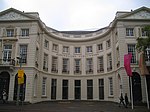Het Plein

Het Plein (Dutch pronunciation: [ˌɦət ˈplɛin]; English: The Square) is a town square in the old city centre of The Hague in the Netherlands. It is located adjacent to the Binnenhof, the meeting place of the States General of the Netherlands; the entrance to the House of Representatives can be found on Plein 2. The Mauritshuis art museum is located on Plein 29.Het Plein was originally a garden, forming a part of the Binnenhof castle, residence of the Counts of Holland. It was used to grow vegetables for the court. The garden was surrounded by a ring of canals and intersected by ditches. As a town square, Het Plein was constructed in 1632 and was inspired by the Place des Vosges in Paris. A statue of William the Silent, made by Dutch sculptor Lodewyk Royer, was installed in the centre of the square in 1848.
Excerpt from the Wikipedia article Het Plein (License: CC BY-SA 3.0, Authors, Images).Het Plein
Plein, The Hague Centrum
Geographical coordinates (GPS) Address Nearby Places Show on map
Geographical coordinates (GPS)
| Latitude | Longitude |
|---|---|
| N 52.0800533 ° | E 4.3157279 ° |
Address
Pleingarage
Plein 25
2511 CS The Hague, Centrum
South Holland, Netherlands
Open on Google Maps










